Related Research Articles

Puja is a worship ritual performed by Hindus to offer devotional homage and prayer to one or more deities, to host and honour a guest, or to spiritually celebrate an event. It may honour or celebrate the presence of special guests, or their memories after they die. The word puja is roughly translated into English as 'reverence, honour, homage, adoration, or worship'. Puja, the loving offering of light, flowers, and water or food to the divine, is the essential ritual of Hinduism. For the worshipper, the divine is visible in the image, and the divinity sees the worshipper. The interaction between human and deity, between human and guru, is called a Darshanam.

Mahabali, also known as Bali, Indrasenan, or Māveli, is a daitya king featured in Hinduism. He is the grandson of Prahlada, and a descendant of the sage Kashyapa. There are many versions of his legend, in ancient texts such as the Shatapatha Brahmana, Ramayana, Mahabharata, and several Puranas. According to Hindu literature, he was blessed to be one of the Chiranjivi, a group of seven immortals, by the Vamana avatar of Vishnu and reigns in the Sutaloka.
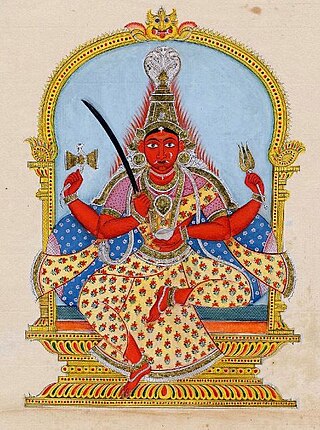
Mariamman, often abbreviated to Amman, is a Hindu goddess of weather, predominantly venerated in the rural areas of South India. Her festivals are held during the late summer/early autumn season of Ādi throughout Tamil Nadu and the Deccan region, the largest being the Ādi Thiruviḻa. Her worship mainly focuses on bringing rains and curing diseases like cholera, smallpox, and chicken pox. Mariamman is worshipped in accordance with local traditions such as Pidari or the Gramadevatai. She is considered as a guardian deity by many South Indian village-dwellers.
Lohana are a trading or mercantile jāti mostly in India and also in Pakistan.

A gramadevata is the tutelary deity of a given locality in Hinduism, primarily worshipped in the villages of India.
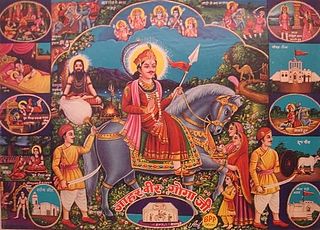
Gogaji, also known as Gogaji Maharaj, is a folk deity in Rajasthan. He is worshipped in the northern states of India especially in Rajasthan, Himachal Pradesh, Haryana, Uttarakhand, Punjab region, Uttar Pradesh, Jammu and Gujarat. He is a warrior-hero of the region, venerated as a saint and a protector against snake bites. Although there are references to him in the folklore of Rajasthan, little historical knowledge of Gugga exists other than that he ruled the small kingdom of Dadrewa and was a contemporary of Prithviraj Chauhan.
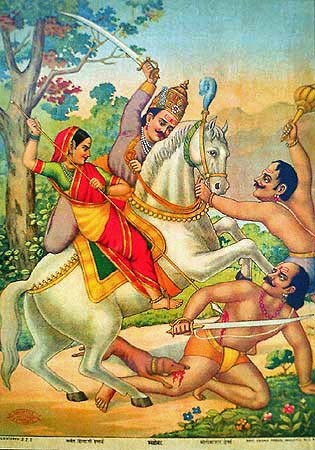
Khandoba, also known as Martanda Bhairava,, Malhari,Mylaralinga,Bandarada Odeya and Malhar, is a Hindu deity worshiped as a manifestation of Shiva mainly in the Deccan plateau of India, especially in the state of Maharashtra and North Karnataka. He is the most popular Kuladevata in Maharashtra. He is also the patron deity of some warrior, farming castes, shepherd community and Brahmin (priestly) castes as well as several of the hunter/gatherer tribes that are native to the hills and forests of this region. The sect of Khandoba has linkages with Hindu and Jain traditions, and also assimilates all communities irrespective of caste, including Muslims. The form of Khandoba developed during the 9th and 10th centuries from a folk deity into a composite god possessing the attributes of Shiva, Bhairava, Surya and Kartikeya (Skanda). He is depicted either in the form of a linga, or as an image of a warrior riding on a bull or a horse. The foremost centre of Khandoba worship is the Khandoba temple of Jejuri in Maharashtra. The legends of Khandoba, found in the text Malhari Mahatmya and also narrated in folk songs, revolve around his victory over demons Mani-malla and his marriages.
Jalaram Bapa popularly known as Bapa (4 November 1799 – 23 February 1881 was a Hindu saint from Gujarat, India. He was born on 4 November 1799, one week after the Hindu festival of Diwali, which is associated with his Iṣṭa-devatā Lord Rama. He is mainly worshipped in Gujarat. Thursday is the day that is associated with him in Hinduism. Images of Jalaram Bapa usually portray him as wearing white, with a stick in his left hand and a tulsi mala in his right hand. He is always dressed in simple clothes which is a symbol of purity.

A kuladevata, also known as a kuladaivaṃ, is an ancestral tutelary deity in Hinduism and Jainism.

Shreenath Mhaskoba is Kaal bhairava an Avatar of the Hindu deity Shiva. The clan deity of many Hindus, the worship of Kaala Bhairava as Shreenath Mhaskoba was popularized by the caste. He is also worshipped by tribal and pastoral people at, Mhaswad, [Borban] and [Sonari].

The village deities of Southern India are the numerous spirits and other beings venerated as part of the Dravidian folk tradition in villages throughout South India. These deities, mainly goddesses, are intimately associated with the well-being of the village, and can have either benevolent or violent tendencies. These deities are presently in various stages of syncretism or assimilation with mainstream Hindu traditions.

Hinglaj is an important Hindu pilgrimage place in Balochistan, Pakistan and Kuldevi of many Jats, Rajput, Charan, Rajpurohits and other Hindu Communities of India. It is situated in Balochistan province about 250 km west-northwest of Karachi. The Shri Hinglaj Mata mandir which is the largest Hindu pilgrimage centre in Pakistan is located here.

Karuppusamy, also known as Karuppu or Karuppannaswamy(Tamil: கருப்பண்ணசுவாமி Malayalam: കറുപ്പണ്ണസാമി ),(lit. 'Black God' or 'Black') is a Hindu god in Tamil Nadu, popular among the social groups of Tamil Nadu and Kerala and also Sri Lanka. He is one of 21 guardian deities of Ayyanar, and is one of 21 guardian deities in Dravidian folk religion.

Vachharadada or Vachhrajdada is a Hindu deity from Gujarat in India. He is an eminent warrior-hero of the region. Hindus honor him as a deity.

Shashthi or Shashti is a Hindu goddess, venerated in Nepal and India as the benefactor and protector of children. She is also the deity of vegetation and reproduction and is believed to bestow children and assist during childbirth. She is often pictured as a motherly figure, riding a cat and nursing one or more infants. She is symbolically represented in a variety of forms, including an earthenware pitcher, a banyan tree or part of it or a red stone beneath such a tree; outdoor spaces termed shashthitala are also consecrated for her worship. The worship of Shashthi is prescribed to occur on the sixth day of each lunar month of the Hindu calendar as well as on the sixth day after a child's birth. Barren women desiring to conceive and mothers seeking to ensure the protection of their children will worship Shashthi and request her blessings and aid. She is especially venerated in eastern India.
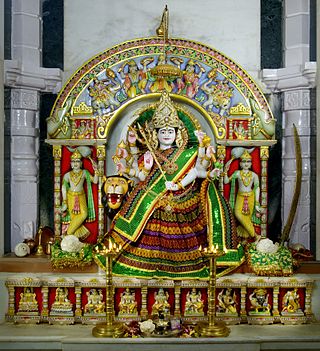
Ashapura Mata is an aspect of Devi, a Hindu goddess. She is one of the kuldevis of Kutch and Rajasthan, and the Jadeja clan of Gujarat, Chauhans and Patiyats inhabiting the western Indian provinces. She is a goddess regarded to fulfill the wishes of her adherents.
Bhanushali is a Hindu community. The majority reside in Kutch district of the Indian state of Gujarat. Some are also found in the Saurashtra region and other parts of Gujarat. Some have also moved to Thane and Mumbai region of Maharashtra. They speak Kutchi language which is alike Gujarati.
Rana Vachhraj was a king of Lohar-Gadha in 13th century AD in what is now Afghanistan. Rana was the elder son of Rana Vasupal and elder brother of Rana Jashraj and their only sister Harkor.
Harkor is the Kuldevi of the Lohana clan. She is worshiped by Lohanas along with her brother Rana Jashraj.
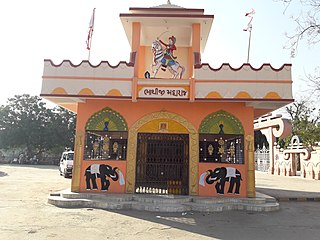
Bhathiji also called Bhathiji Maharaj is a folk deity of Gujarat. He is an eminent warrior-hero of the region.
References
- ↑ Thakur, Upendra (1959). Sindhi Culture. University of Bombay. p. 175.
- 1 2 Lachaier, Pierre (1999). Firmes et entreprises en Inde: Ia firme lignagere dans ses reseaux. KARTHALA Edition. p. 70. ISBN 978-2-86537-927-9.